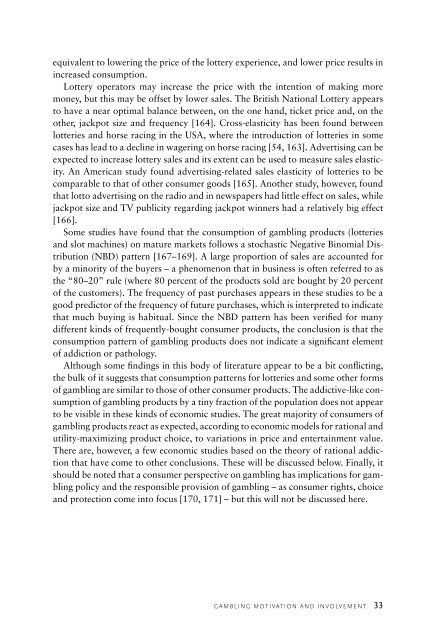Gambling motivation and involvement: A review of social
Gambling motivation and involvement: A review of social
Gambling motivation and involvement: A review of social
You also want an ePaper? Increase the reach of your titles
YUMPU automatically turns print PDFs into web optimized ePapers that Google loves.
equivalent to lowering the price <strong>of</strong> the lottery experience, <strong>and</strong> lower price results in<br />
increased consumption.<br />
Lottery operators may increase the price with the intention <strong>of</strong> making more<br />
money, but this may be <strong>of</strong>fset by lower sales. The British National Lottery appears<br />
to have a near optimal balance between, on the one h<strong>and</strong>, ticket price <strong>and</strong>, on the<br />
other, jackpot size <strong>and</strong> frequency [164]. Cross-elasticity has been found between<br />
lotteries <strong>and</strong> horse racing in the USA, where the introduction <strong>of</strong> lotteries in some<br />
cases has lead to a decline in wagering on horse racing [54, 163]. Advertising can be<br />
expected to increase lottery sales <strong>and</strong> its extent can be used to measure sales elasticity.<br />
An American study found advertising-related sales elasticity <strong>of</strong> lotteries to be<br />
comparable to that <strong>of</strong> other consumer goods [165]. Another study, however, found<br />
that lotto advertising on the radio <strong>and</strong> in newspapers had little effect on sales, while<br />
jackpot size <strong>and</strong> TV publicity regarding jackpot winners had a relatively big effect<br />
[166].<br />
Some studies have found that the consumption <strong>of</strong> gambling products (lotteries<br />
<strong>and</strong> slot machines) on mature markets follows a stochastic Negative Binomial Distribution<br />
(NBD) pattern [167–169]. A large proportion <strong>of</strong> sales are accounted for<br />
by a minority <strong>of</strong> the buyers – a phenomenon that in business is <strong>of</strong>ten referred to as<br />
the “80–20” rule (where 80 percent <strong>of</strong> the products sold are bought by 20 percent<br />
<strong>of</strong> the customers). The frequency <strong>of</strong> past purchases appears in these studies to be a<br />
good predictor <strong>of</strong> the frequency <strong>of</strong> future purchases, which is interpreted to indicate<br />
that much buying is habitual. Since the NBD pattern has been verified for many<br />
different kinds <strong>of</strong> frequently-bought consumer products, the conclusion is that the<br />
consumption pattern <strong>of</strong> gambling products does not indicate a significant element<br />
<strong>of</strong> addiction or pathology.<br />
Although some findings in this body <strong>of</strong> literature appear to be a bit conflicting,<br />
the bulk <strong>of</strong> it suggests that consumption patterns for lotteries <strong>and</strong> some other forms<br />
<strong>of</strong> gambling are similar to those <strong>of</strong> other consumer products. The addictive-like consumption<br />
<strong>of</strong> gambling products by a tiny fraction <strong>of</strong> the population does not appear<br />
to be visible in these kinds <strong>of</strong> economic studies. The great majority <strong>of</strong> consumers <strong>of</strong><br />
gambling products react as expected, according to economic models for rational <strong>and</strong><br />
utility-maximizing product choice, to variations in price <strong>and</strong> entertainment value.<br />
There are, however, a few economic studies based on the theory <strong>of</strong> rational addiction<br />
that have come to other conclusions. These will be discussed below. Finally, it<br />
should be noted that a consumer perspective on gambling has implications for gambling<br />
policy <strong>and</strong> the responsible provision <strong>of</strong> gambling – as consumer rights, choice<br />
<strong>and</strong> protection come into focus [170, 171] – but this will not be discussed here.<br />
G A M B L I N G M O T I VAT I O N A N D I N V O LV E M E N T 33

















